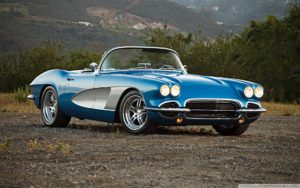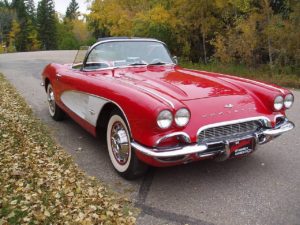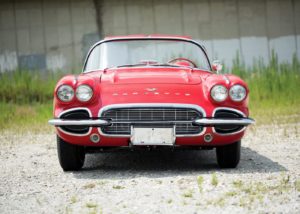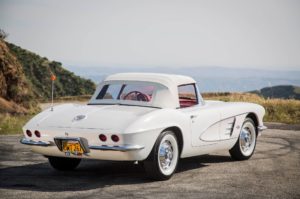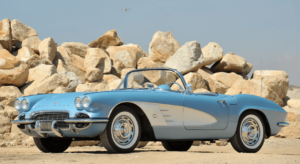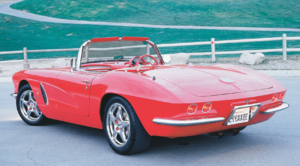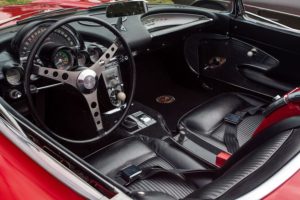By late 1960, the Corvette had demonstrated again that it was a serious contender on the race track, both in mainstream media and in the automotive marketplace. CBS television, in cooperation with General Motors, introduced the series “Route 66”. (While it was common in that era for automotive manufacturing companies to sponsor television programming, this particular series featured a story about two guys who sought adventure in their shiny, new Corvette).
Bill Mitchell had begun the process of developing a prototype for an all-new Corvette that would go on to become known as the “Mako Shark I.” He had also championed a team of Chevrolet designers in developing both cosmetic and performance upgrades to the existing C1 body styling.
Pricing:$3,934.00
Engine options: 283 ci. V-8 (fuel injected or carbureted) – multiple-horsepower options available
Transmission: 3-speed manual (standard), 4-speed manual (optional), 2-speed Powerglide (optional)
Top speed: 131mph
Units produced: 10,931
Available colors: Tuxedo Black, Honduras Maroon, Ermine White, Jewel Blue, Fawn Beige, Roman Red, Sateen Silver
Highlights of the year:
With Corvette sales consistently increasing over the previous two model years, General Motors executives decided to review some of Mitchell‘s designs and made the decision to “green light” a restyling of Corvette for the 1961 model year.
The most pronounced of Mitchell’s changes was the introduction of a freshened rear-end design. The “ducktail” design (as it has become known amongst Corvette enthusiasts) was virtually lifted from the Stingray race car as well as Mitchell’s XP-700 show car
From a practicality standpoint, the redesign of the rear end of the Corvette enabled an increase in available luggage space by twenty percent (20%). The new rear end also showcased a pair of small, round taillights on each side of the license plate recess. (These re-designed tail lights would become synonymous with Corvette and would be a standard feature (in one form or another) on all future generations of Corvette).
Other improvements were made to the Corvette’s body as well, though some were not physical changes to the actual lines of the Corvette so much as an evolution in the quality of how those body lines were put together.
With improvements in fiberglass manufacturing combined with refined assembly processes improving the car’s fit and finish, the 1961 Corvette was quickly recognized by critics and enthusiasts alike as the best-built Corvette yet.
While the exterior received subtle improvements to it’s overall appearance, the interior of the 1961 Corvette went virtually unchanged from its predecessors.
Mechanically, the 1961 Corvette was much like it’s 1960 predecessor. However, an aluminum radiator took the place of the previous copper-core unit. By adding an aluminum radiator, Chevrolet improved the cooling capabilities while further reducing the car’s overall weight. Side mount coolant-expansion tanks were added as a running change.
The available engines were essentially just carryovers from the 1960 Corvette. There were five, different versions of Chevy’s respected 283 cubic-inch V-8 engine made available to consumers, of which two were fuel injected.
While Corvette continued to delay the incorporation of an independent rear suspension, this did nothing to hurt the vehicle in sales or in performance.
Automotive testers were enamored with the quality of the 61’s handling ability, and none of them identified any specific deficiencies or lacking in quality of handling due to the absence of an independent rear suspension.
By the standards of that time, the Corvette was now recognized as one of the most roadworthy cars in the world.
Photos of the 1961 Corvette:
Sources:
https://www.corvsport.com/1961-c1-corvette/
https://www.corvsport.com/1961-c1-corvette-image-gallery/
https://www.pinterest.com/pin/450852612666371935/
